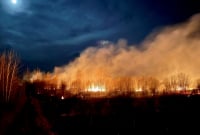Support strong Canadian climate journalism for 2025
The fire department in Slave Lake, Alta., had a long-standing plan for tackling wildfire encroaching on the community, but in May 2011, flames from a nearby forest blew over suppression efforts and destroyed several hundred homes and other buildings.
"I think that was the most shocking time of my entire career and maybe of my life, where you're so sure that something's going to work, and then it doesn't … with crushing consequences," said Jamie Coutts, the former Slave Lake fire chief.
A firefighter for more than 30 years, Coutts said wildfires have been burning "hotter, faster (and) crazier" over the last decade, and "every single person that lives in the forest is on a collision course with something disastrous happening."
Research suggests that so-called interface fires, which occur where forests and flames meet human development, are on the rise.
An interface fire crashed into suburban Halifax on Sunday, destroying or damaging dozens of homes in the west of the city.
The Nova Scotia blaze follows early season wildfires that have forced tens of thousands of people to evacuate from their homes in Alberta.
Sandy Erni, a research scientist with the Canadian Forest Service focusing on fire risk, said interface fires can involve either residential neighbourhoods or industrial infrastructure.
Erni is the co-author of a 2021 study that used greenhouse-gas emissions scenarios established by the Intergovernmental Panel on Climate Change to model potential increases in wildland-human interface fires by the end of this century.
The study published in the Canadian Journal of Forest Research concluded that interface fires are increasing in frequency, particularly in northern and central areas, and the number of people exposed to the blazes is likely to grow considerably.
Fortunately, in Canada, people are mostly escaping wildfires with their lives, said Coutts, although a fast-moving blaze killed two people and destroyed much of the village of Lytton in British Columbia's southern Interior in late June 2021.
In northern California, 85 people were killed in 2018 when a wildfire turned into an urban inferno that destroyed most of the town of Paradise.
"What would the pushback be from the public in Canada if people started to die, and why do we have to wait for that?" Coutts said in an interview.
"Why can't we make a change now, before we have those kinds of losses?"
Coutts wants to see a more widespread adoption of FireSmart guidelines, which aim to reduce wildfire risks to homes, communities and critical infrastructure, as well as changes to national and provincial building codes to address building materials, the space allowed between structures and the proximity of trees.
Some homeowners may choose to reduce the risk of interface fire by removing trees and vegetation, installing sprinklers and choosing less flammable materials for roofing and siding, he said, although not everyone can afford such measures.
Wildfire is unpredictable, especially when wind is a factor, said Coutts, adding he's seen people's homes burn after they did "all the right things" to reduce the risk.
Erni said the Canadian government has undertaken a national wildfire risk assessment, with mapping set to be publicly released next year.
Each region and community has its own risk profile depending on factors including the local climate and the types of trees and vegetation in the surrounding forest.
In general, communities within the Boreal zone — which encompasses 75 per cent of the country's forests and woodlands — are at higher risk than others, said Erni, who's based at the Great Lakes Forestry Centre in Sault Ste. Marie, Ont.
The rising threat of interface fire is clear, but without regionally specific climate modelling, it's hard to say exactly how that risk will change over time, she said.
This report by The Canadian Press was first published May 30, 2023.





Comments